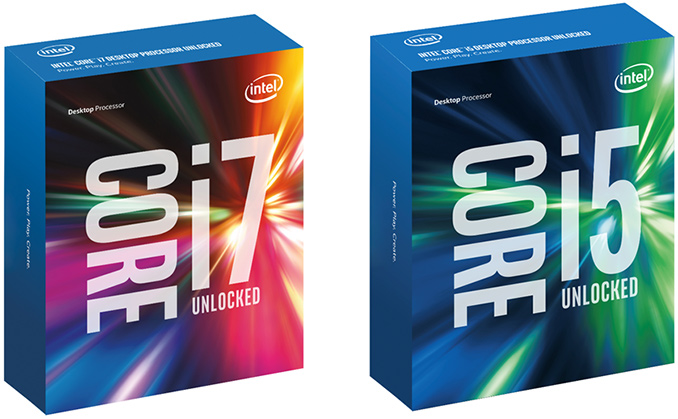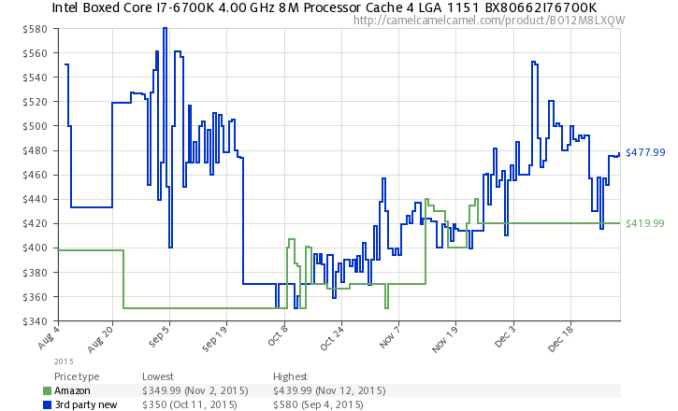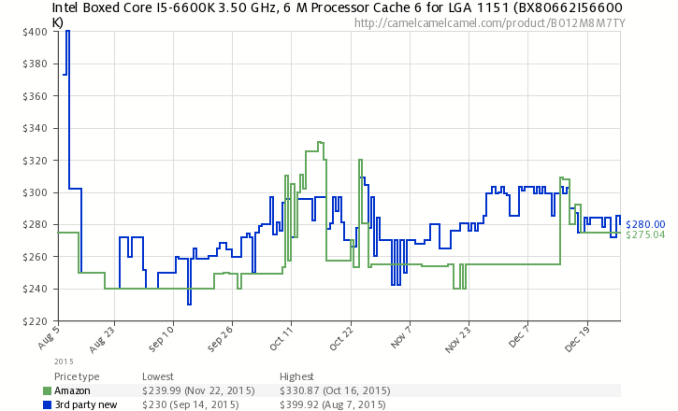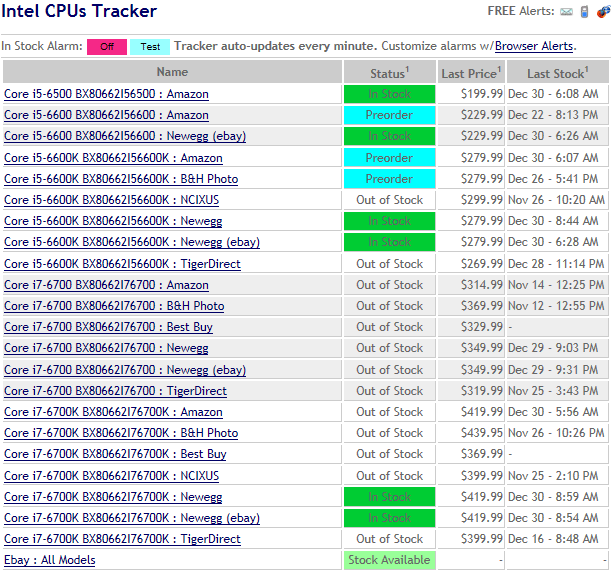Price Check: Intel's Core i7-6700K CPU In Short Supply
by Anton Shilov on December 30, 2015 8:00 AM EST
Demand for Intel’s Skylake CPUs has been very high since the introduction of the company’s latest processors in August. Even though the manufacturer has ramped up the supply of its Skylake CPUs since its launch, not all users can get these new CPUs. In fact, demand for higher-end Core i5-6600K and Core i7-6700K is so high that retailers recently increased prices of such chips. As a result, the quad-core top-of-the-range Skylake-S microprocessor is now more expensive than even the previous-generation six-core Haswell-E series.
Officially, the recommended customer price of one boxed Intel Core i7-6700K processor (four cores with Hyper-Threading, 4.0GHz/4.20GHz, 8MB cache, Intel HD Graphics 530 core, unlocked multiplier) is $350, according to Intel’s ARK. The recommended price of the Core i5-6600K chip (four cores, 3.50GHz/3.90GHz, 6MB cache, Intel HD Graphics 530 core, unlocked multiplier) is $243. However, at the moment it is not easy to buy thse CPUs without overpaying in the U.S. In fact, not all retailers even have the chips in stock, something that rarely happens to products released over three months ago.
For their part, Amazon does not currently have any Intel Core i7-6700Ks directly in stock. Instead the only 6700Ks available via Amazon are through their third-party marketplace sellers, starting at $499.99, which is nearly $150 higher than the recommended customer price. According to CamelCamelCamel, a price-tracker that monitors Amazon and its partners, the price of the chip began to increase in early October. Meanwhile Newegg sells the Core i7-6700K for $419.99, a smaller increase than Amazon but still higher than both Intel's original price recommendation and the price Newegg was charging at launch. Looking at Newegg's pricing history over at PriceZombie, it looks like Newegg increased the price of the chip beginning in November.
As for Intel’s Core i5-6600K, it's available at Amazon and Newegg for $289.99 and $279.99, respectively. The price of the chip has been fluctuating in both stores and at present the product costs slightly above its $243 MSRP.
Given these prices, it is noteworthy (and somewhat surprising) that Intel’s Core i7-5820K processor (six cores with Hyper-Threading, 3.30GHz/3.60GHz, 15MB cache, unlocked multiplier) is down to $389.99 these days, which makes it cheaper than the Skylake 6700K. The fact that the 5820K has to be paired with more expensive LGA2011-3 motherboards as well as quad-channel memory kits ultimately drives up the price of the total kit compared to a Skylake system, but that a still very performant hex-core CPU (ed: with solder!) is cheaper than Intel's flagship quad-core is something we rarely see. If nothing else it's a sign of just how unbounded quad-core pricing has become, though at the same time it thankfully provides a reasonable alternative to the 6700K and some counter-pressure to keep i7 prices from getting even higher.
When we asked Intel about what was going on with Skylake prices, they said in an emailed statement that they had not increased the MSRP of the 6600K/6700K - in other words, they had not increased prices on their end. Instead they suggested that select stores might have increased their prices because of strong demand for such chips, which is a pattern we've seen before with video cards and other components.
It goes without saying that retailers do not usually increase prices without a reason, as the intense competition among the online PC component retailers makes it difficult to hold too large of a margin under normal circumstances. All of this in turn points to an insufficient supply of microprocessors, with demand significantly exceeding supply. In fact, according to Nowinstock, which monitors availability of various products, many well-known U.S.-based stores did not have high-end Intel Skylake CPUs in their stocks at press time.
Intel has previously mentioned that the costs of producing CPUs on their 14nm manufacturing process were higher than the costs of 22nm CPUs due to initially lower 14nm yields. However, the company has never revealed whether yields are a reason why higher-end Skylake-S processors are currently in short supply, or if the problem lies elsewhere in the production chain. With any luck we may find out a bit more once Intel hosts their next earnings conference call in January.













103 Comments
View All Comments
lilmoe - Wednesday, December 30, 2015 - link
If you're workload doesn't included extensive multi-threaded rendering, I'd say the 4790K is the most appealing chip currently available.bji - Wednesday, December 30, 2015 - link
Agreed, and it's what I've been buying. But the price hasn't dropped in well over a year on that part. Weird times.In a way it feels like the average cost per year of processors is still dropping though because the newer processors may cost as much as the older ones, but have a longer useful lifespan. Perhaps that's the metric that Intel is trying to hold constant with its pricing strategies.
jasonelmore - Wednesday, December 30, 2015 - link
yeah they only knock off $15 when the next generation comes out.. might as well get the new generation. now if it were something reasonable like $50 or $75, but intel's smarter than thatHinton - Wednesday, December 30, 2015 - link
I'd prefer the 5775C over thr 4790K, since I play computer games.If I didn't play games, an i3 would be my choice.
eek2121 - Wednesday, December 30, 2015 - link
I'm willing to bet that Intel is restricting the supply more than anything. I don't know of any of my friends who has upgrade to Skylake. Most of us are still happily on our i7/2600ks or our i7/4790ks.Mondozai - Wednesday, December 30, 2015 - link
It's a conspiracy theory, but one that makes sense. After all, Intel has long used shadowy tactics(contra-revenue being one) to gain market share and/or squeeze more profits out of their products.Intel's still heavily into desktop PCs and servers. Their mobile showing has been quite laughable, they're not only an also-ran but soon a no-name. As such, in an environment with falling PC sales, ginning up the price even more than reducing supply would induce the cushion for them to re-orient their company.
Especially with the recent buy of Altera, they're pushing into IoT and all kinds of areas but they did the same with mobile and got nowhere. For now, their cash cow needs to deliver.
ddarko - Wednesday, December 30, 2015 - link
No, this conspiracy theory doesn't make sense because Intel doesn't get a bigger cut from the higher RETAIL price. The price Intel receives is the WHOLESALE price and there's been zero talk, rumors or evidence that Intel has increased the price it's charging to sell the chips to the retailers. The only people who benefit from the elevated retail price are the retailers charging and pocketing the elevated retail prices..The likely cause is low yields. The problems Intel has had transitioning to the 14nm process are extensive and publicly documented. Intel delayed the launch of Skylake, screwed up the release desktop Broadwell before it, and finally abandoned its longstanding tick-tock release cadence going forward. It makes far more reasonable that Intel is still struggling to make its 14nm yields up.
CaedenV - Wednesday, December 30, 2015 - link
yes and no... don't they use the same fab buildings to build the much more expensive Xeon chips? Could be they are pouring their output into those which is then restricting i5/i7 production.kpb321 - Wednesday, December 30, 2015 - link
The Xeon chips are always a generation or two behind on the CPU design and on the process so they haven't started making any major 14nm Xeon processors as far as I know. Might have some 14nm Xeons in some of the embedded or workstation only lines but the "real" 2 and 4 socket Xeon chips aren't on 14nm and would be horrible to do on it. Those chips are huge chips and need a much more mature manufacturing process to help the yields be acceptable. Best chips for a new process with poor yields are smaller chips, not larger ones. That is why broadwell was primarily the low power low core count variations and why you see mobile chips transition quite early.extide - Wednesday, December 30, 2015 - link
Uhh, yes they have. Infact 14nm is mostly being used for Xeon EP v4 (Broadwell), Xeon-D, and Knights Landing which are all fairly large chips (>300mm, ~250mm, and 650+mm respectively) so I highly doubt yield is the issue right now. It's simply that the profit margins on the aformentioned chips are WAY higher.